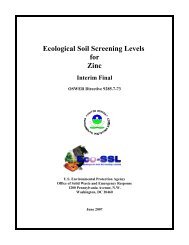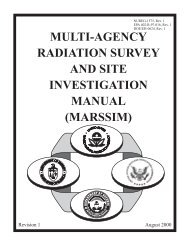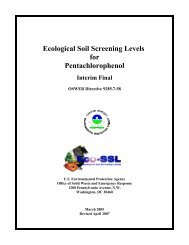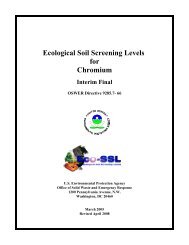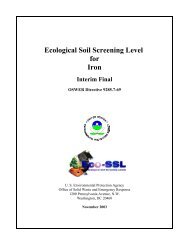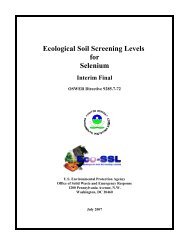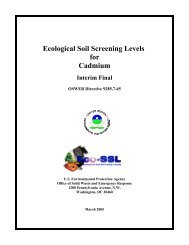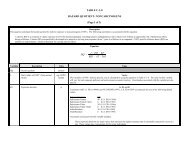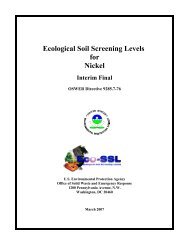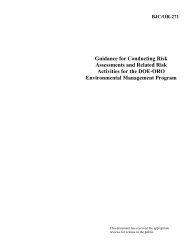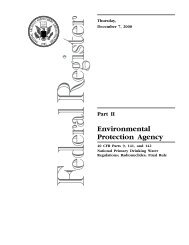Understanding Variation in Partition Coefficient, Kd, Values Volume II
Understanding Variation in Partition Coefficient, Kd, Values Volume II
Understanding Variation in Partition Coefficient, Kd, Values Volume II
Create successful ePaper yourself
Turn your PDF publications into a flip-book with our unique Google optimized e-Paper software.
4.0 Application of Chemical Reaction Models<br />
Computerized chemical reaction models based on thermodynamic pr<strong>in</strong>ciples may be used to calculate<br />
processes such as aqueous complexation, oxidation/reduction, adsorption/desorption, and m<strong>in</strong>eral<br />
precipitation/dissolution for contam<strong>in</strong>ants <strong>in</strong> soil-water systems. The capabilities of a chemical reaction<br />
model depend on the models <strong>in</strong>corporated <strong>in</strong>to its computer code and the availability of thermodynamic<br />
and/or adsorption data for aqueous and m<strong>in</strong>eral constituents of <strong>in</strong>terest. Chemical reaction models,<br />
their utility to understand<strong>in</strong>g the solution chemistry of contam<strong>in</strong>ants, and the MINTEQA2 model <strong>in</strong><br />
particular are described <strong>in</strong> detail <strong>in</strong> Chapter 5 of <strong>Volume</strong> I.<br />
The MINTEQA2 computer code is an equilibrium chemical reaction model. It was developed with<br />
EPA fund<strong>in</strong>g by orig<strong>in</strong>ally comb<strong>in</strong><strong>in</strong>g the mathematical structure of the MINEQL code with the<br />
thermodynamic database and geochemical attributes of the WATEQ3 code. The MINTEQA2 code<br />
<strong>in</strong>cludes submodels to calculate aqueous speciation/complexation, oxidation-reduction, gas-phase<br />
equilibria, solubility and saturation state (i.e., saturation <strong>in</strong>dex), precipitation/dissolution of solid phases,<br />
and adsorption. The most current version of MINTEQA2 available from EPA is compiled to execute<br />
on a personal computer (PC) us<strong>in</strong>g the MS-DOS computer operat<strong>in</strong>g system. The MINTEQA2<br />
software package <strong>in</strong>cludes PRODEFA2, a computer code used to create and modify <strong>in</strong>put files for<br />
MINTEQA2.<br />
The MINTEQA2 code conta<strong>in</strong>s an extensive thermodynamic database for model<strong>in</strong>g the speciation and<br />
solubility of contam<strong>in</strong>ants and geologically significant constituents <strong>in</strong> low-temperature, soil-water<br />
systems. Of the contam<strong>in</strong>ants selected for consideration <strong>in</strong> this project [chromium, cadmium, cesium,<br />
tritium ( 3 H), lead, plutonium, radon, strontium, thorium, and uranium], the MINTEQA2 thermodynamic<br />
database conta<strong>in</strong>s speciation and solubility reactions for chromium, <strong>in</strong>clud<strong>in</strong>g the valence states Cr(<strong>II</strong>),<br />
Cr(<strong>II</strong>I), and Cr(VI); cadmium; lead; strontium; and uranium, <strong>in</strong>clud<strong>in</strong>g the valence states U(<strong>II</strong>I), U(IV),<br />
U(V), and U(VI). Some of the thermodynamic data <strong>in</strong> the EPA version have been superseded <strong>in</strong> other<br />
users’ databases by more recently published data.<br />
The MINTEQA2 code <strong>in</strong>cludes 7 adsorption model options. The non-electrostatic adsorption models<br />
<strong>in</strong>clude the activity K d act , activity Langmuir, activity Freundlich, and ion exchange models. The<br />
electrostatic adsorption models <strong>in</strong>clude the diffuse layer, constant capacitance, and triple layer models.<br />
The MINTEQA2 code does not <strong>in</strong>clude an <strong>in</strong>tegrated database of adsorption constants and reactions<br />
for any of the 7 models. These data must be supplied by the user as part of the <strong>in</strong>put file <strong>in</strong>formation.<br />
Chemical reaction models, such as the MINTEQA2 code, cannot be used a priori to predict a<br />
partition coefficient, K d, value. The MINTEQA2 code may be used to calculate the chemical changes<br />
that result <strong>in</strong> the aqueous phase from adsorption us<strong>in</strong>g the more data <strong>in</strong>tensive, electrostatic adsorption<br />
models. The results of such calculations <strong>in</strong> turn can be used to back calculate a K d value. The user<br />
however must make assumptions concern<strong>in</strong>g the composition and mass of the dom<strong>in</strong>ant sorptive<br />
substrate, and supply the adsorption parameters for surface-complexation constants for the<br />
4.1



